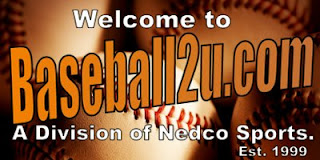By guest author: Nick Dixon
Baseball sliding is an important skill for baseball players to master. It is every baseball coaches responsibility to teach every player how to slide safely. Every player should know the different kinds of slides and when each type slide is used. This article explains the three safest types of baseball slides and gives coaching points for each.
Sliding is difficult to practice. I can be relatively to easy teach if the coach knows how to properly execute each slide. Until players have a chance execute slides repetitively, they do not gain the confidence they should have to use the slides in a game. The best ways to practice baseball sliding if you do not have a slide practicing mat, is to wet the grass, use nylon cloth or card board on gym floors, or practice sliding in soft loose dirt.
There are a couple of basic safety points that should be remembered when executing all baseball slides. You must start the slide at least four steps from the bag. Sliding late is a commonly cause of ankle and leg injury. Keeping the hands high also prevent injury to hands, fingers and wrist.
Pop-Up or Stand-Up Slide - This slide is the safest and most popular sliding technique. It offers one definite advantage over other slides. The pop-up slide allows runners to advance more easily should an errant throw be made by the defense.
Three coaching points for the stand-up slide:
1. The left leg is bent and is under the right leg. The right leg is extended and it should be slightly bent.
2. The runner slides evenly on both lower cheeks of his rear end or on both back pockets.
3. The runner should adjust the slide path according to the position the fielder has assumed and where the tag glove is likely to be placed. The runner can touch the bag with his foot going directly into the bag or with a hand if the runner slides away from the bag.
Hook Slide - The hook slide is so named because of the "bent or hooked" positions of the legs during the slide and the fact that the bag is "hooked" or tagged with the back foot. The slide can to the right or left of the bag as the play requires.
Three coaching points for the "Hook" slide are:
1. The runner slides on one hip pocket or the other. The body is tilted during the slide. The body should be titled toward the side of the bag on which the slide is being made.
2. The bag is tagged with the back foot.
3. The hook slide is often used by runners attempting to break up a double play. It is also a good slide to use when trying to avoid an awaiting tag by the defender.
Reach-Around or Decoy Slide - The decoy slide is the most difficult to tech, learn, master and practice. It is a slide used when the ball beat the runner to the bag by 5 steps. The decoy slide is used to fool or trick the player making the tag. The sliding runner will fake tagging the bag with one hand and use the other hand to reach around the tag. The decoy is used only as a "last resort" to try avoiding a tag when the runner find himself "dead-to-rights" and sees the ball and tag waiting on him.
Three coaching points for the "Decoy" slide are:
1. The decoy slide must be started earlier than other slides.
2. The decoy slide should be made some distance away from the bag. The distance should allow the runner to reach the bag with both hands. The distance should require the fielder to reach way from the bag to make the tag. This reaching motion gives the runner a spot to avoid and reach around. The secret is to "sucker" the defender with one hand, then withdraw that hand, and reach around the tag with the other hand avoiding a tag and reaching the bag safely.
3. The sliding technique used at the beginning of the slide is the "stand-up" slide.
Note: I intentionally did not list the "head first" slide in this article. It is illegal in most leagues. It is a slide that is considered the most dangerous and risky. It has been the cause of many serious injuries. Coaches should consider the liability risk before teaching it as a method of sliding. I personally recommend to my players that they do not slide head first.
I hope that you found this article useful and informative. Thanks for taking the time to read this article. Have a great day, Nick.
The CoachesBest Baseball Store has a great selection of 1400 Baseball Products. Check out the BatAction Hitting Machine baseball pitching simulator. This high speed training machine is 100% Guaranteed to raise Batting Averages and has a full year warranty.
Nick Dixon is the President and founder of Nedco Sports, a sports training company established in 1999. Dixon is also an active and full time high school baseball coach with over 25 years experience. Coach Dixon is better known as the inventor of the BatAction Hitting Machine, the SKLZ Derek Jeter Hurricane Hitting Machine, the SKLZ Target Trainer, the SKLZ Derek Jeter ZipnHit Pro, and the SKLZ Strikeback Trainer. Dixon is also a contributing writer for BaseballCoachingDigest, the Youth Baseball Digest, the Baseball Parent Guide, the Baseball 2Day Coaches Journal, and Blog4Coaches.
Article Source: http://EzineArticles.com/?expert=Nick_Dixon
========================
Thanks to our sponsors:
www.BatAction.com

---BatAction Machine at CoachesBest.com
---BatActionMachine on Ebay.com
---BatAction Machine Video Clips
---BatAction Trainer - 15 Reasons Why You Must Own This Machine
---Message to Parents From Coach Nick
---If you are looking for BatAction Replacement Balls or Power Bands Click Here





